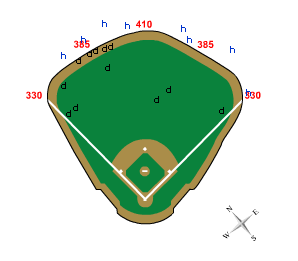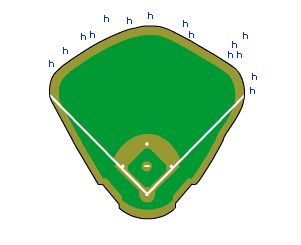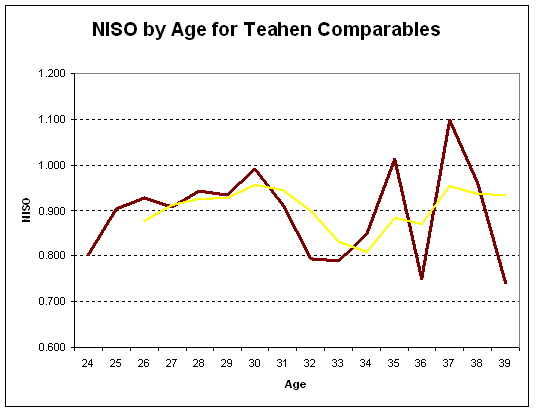BP Comment Quick Links

 | |
August 31, 2006 Schrodinger's BatThe Curious Case of Mark Teahen
"I think it's well-documented how I feel about [Teahen], and how I feel about him as a ballplayer. I don't need to add anything to that discussion." --Former Royals General Manager Allard Baird, perhaps with an "I told you so" when asked about the third baseman's breakthrough season. On August 22nd of this season, Mark Teahen, Royals third baseman and former centerpiece of the deal that sent Carlos Beltran to Houston at the trading deadline in 2004, stepped in against the Indians' Cliff Lee in the first inning. Teahen would blast a two-run home run, his 16th of the year. Rather than call it a day, Teahen would add two doubles and a single, steal two bases (one of third base), and score the go-ahead run in a 5-2 Royals victory. My, how times have changed. At this time last year, eight total bases in one game would have seemed like a pipe dream for a player many were starting to consider a bust, and nothing more than a product of overblown Moneyball hype. No longer: going into Tuesday's action, Teahen was hitting .296/.368/.535 overall, and had hit an especially robust .337/.421/.633 with ten home runs since the All-Star break. That adds up to a WARP1 of 5.3 and an Equivalent Average of .305, two numbers that suggest that Teahen, at least, might heal one of the many wounds of Royals fans, and in a small way redeem the reputation of former GM Allard Baird. Beyond the raw performance, what we really want to know is what's behind his turnaround, and whether or not we can expect this kind of performance to continue. This week, we'll address both by revisiting the themes of an article I wrote last season. Where He's Been The primary question about Teahen, even before he was drafted, was when or if the 6'3" 210-pounder would develop power. Teahen had always hit the ball the other way with a swing he mastered in innumerable childhood wiffle-ball games played against his brothers. In Moneyball, Michael Lewis used Teahen as an example of the new thinking in player development by relating a conversation between then-scouting director Eric Kubota, a scout, and GM Billy Beane. In Lewis' version, Beane ends the speculation about Teahen by noting that "power is something that can be acquired. Good hitters develop power. Power hitters don't become good hitters." The A's drafted Teahen in the first round with the 39th pick of the 2002 draft, even though he had hit just ten homeruns in over 600 plate appearances during his three seasons at St. Mary's College of California. The A's attempted to help him develop power by getting him to pull the ball, according to Lewis:
To teach him how to pull the ball, the Oakland staff took Teahen into a room and showed him tapes of Jason Giambi. Giambi once had been just like him, they said: a third baseman who hit well but not powerfully. At the end of his first season, Oakland sent Teahen to a training center in Florida with instructions to gain 15 pounds and drop his body fat from 15 percent to 10 percent. He made a halfhearted stab at it-and put on fat. ("I'm not sure how you do that, gain 15 pounds and lose all that body fat," he says. "It'd be a lot easier if they didn't include the body-fat part of it.") The extra weight made him feel clunky. And the attempt to pull the ball felt wrong. He dropped the weight, and kept on hitting the ball the other way. He didn't want to be Jason Giambi. He wanted to be Mark Teahen. After that experiment failed and he was traded to the Royals in the Beltran deal, his new team also attempted to get him to pull the ball, sitting him down with no less an authority on hitting than Hall of Famer George Brett. Brett introduced Teahen to the Charley Lau approach to hitting for a couple of days. At the time, that didn't seem to quite have the intended results either:
For two days, with Brett looking on, Teahen went into the Triple-A batter's box and cantilevered backward, bat lowered and tucked tightly against his back shoulder. Just like George Brett! Then Brett left--and Teahen went right back to hitting a baseball the way he always had. "Two days!" Brett said, six months later, not knowing whether to laugh or scream. "That kid, he did what I showed him for two days…Then the moment I left he went back to doing it his way." As a result, up until this year Kubota's skepticism about Teahen seemed to be well-justified. In 1,468 minor league plate appearances, Teahen hit a grand total of 18 home runs, one more than he has this season in a quarter of the plate appearances, although 14 of those came in 2004 while he split time between Double- and Triple-A. All told, he put up a career minor league slugging percentage of just .409. Annointed as the Royals' third baseman in spring training last season, he continued his light-hitting ways by hitting a meager .246/.309/.376 in 491 plate appearances. All of this led our PECOTA system to list his top five comparables coming into 2006 a squad of non-stars:
That's not an impressive group, to say the least, although Jim Edmonds comes in as Teahen's seventh comparable, and Larry Walker shows up at 11. In addition, the five-year forecast never had him above 12 home runs or a .448 slugging percentage, and he was given a dangerously high attrition rate of 23%. At best, that forecast made him a serviceable player, worth around two to three wins per year, but certainly unspectacular. It was a projection of a player vulnerable to, in an evolutionary sense, being selected out of the majors as a third basemen or corner outfielder. Given this scenario and the similar low-wattage disappointments trailing another hyped third base prospect, Sean Burroughs (who has since been released by the Devil Rays after hitting just .214 in 37 games at Durham), I wrote a piece last July that took a look at both of their performances up to that time, and tried to find comparable players using Isolated Power (ISO) to get a historical sense of just what they were up against. Basically, the idea was to use ISO (slugging percentage minus batting average, providing a measure of the number of extra bases a player generates) to see how frequently players that matched their profile (defined as 1,000 or more at bats plus walks before the age of 24) went on to develop greater than average power. I also normalized ISO to both park and league by creating Normalized ISO (NISO) for the comparisons. What I found was that there did appear to be some precedent for players like Teahen increasing their power, notably infielders Roy Smalley, Lou Whitaker, Toby Harrah, and George Brett, and outfielders Kirby Puckett and Roberto Clemente. I also found that players who made the largest gains in ISO after their Age-24 season typically make great gains between 24 and 27, and reach their peak performance by 28 before beginning a slow, gradual descent. What He's Doing As Royals fans well know, the change in Teahen correlates with his demotion to Omaha on May 6th. When sent down, he was hitting just .195 (15 for 77) with two home runs. Down in Omaha, he worked with hitting instructor Terry Bradshaw, providing strong support that in this case correlation is indeed causation:
Omaha hitting instructor Terry Bradshaw made a video of Teahen's good at-bats from last year. What better way to teach a stubborn student than to let him learn from himself? The mechanical changes were subtle. They shortened Teahen's swing, kept his hands back, and made a minor adjustment with his hips that allowed him to hit inside pitches better. In addition, Teahen revealed in an online chat last month that Bradshaw emphasized that he start using his legs more. As Teahen himself says, "That has resulted in harder contact and ultimately pulling the ball more often." Although Brett may have thought that his advice had no effect, it now appears that Teahen absorbed what the Hall of Famer was teaching, and has been working on incorporating it into his approach: I took what he told me and tried to find out mechanically what I could do to get that same effect. I wasn't going to look like George Brett at the plate, but I was going to try to use some of his ideas to get me in that same position. The results are fascinating. Using data from the excellent FanGraphs site we can see that the combination of subtle mechanical changes, more emphasis on using his legs to generate torque, and confidence has led to a sea change in how Teahen puts the ball in play.
Year GB/FB LD% GB% FB% HR/FB ------------------------------------------- 2005 2.22 23.5% 52.8% 23.8% 8.6% 2006 1.39 14.6% 49.7% 35.8% 16.5% The result is that his line drives are turning into fly balls (up over 50%), and those fly balls are being driven out of the park or deep into the gaps. His profile has turned from one common to a contact hitter to one that looks more like the Phillies' Ryan Howard, albeit with a few more ground balls. In the meantime, Teahen's batting average on balls in play is at .336, somewhat higher than the league average (around .300). Coupled with his relatively low line-drive percentage, it remains to be seen whether his refinements will allow him to maintain a BABIP that high, or whether he'll regress somewhat. Keep in mind that we're still talking only about a few hundred plate appearances since he was recalled from Omaha. It's also clear that despite Teahen's self-proclaimed increased propensity for pulling the ball, he's still being true to his natural hitting style for the most part, and is not simply looking to yank the ball down the line at every opportunity. The following chart from MLB.com tracking his home runs and doubles at Kauffman Stadium this season indicates that his power is to all fields, especially to left-center:
 The following chart tracking 15 of his 17 home runs (two couldn't be located using the interface) provides a similar picture:
 Where He's Going? So given the apparent turnaround, can history provide any guide to what we might expect from Teahen from here on out? To help answer that question, I did what any good performance analyst might do: I looked for comparable players. I was particularly interested in whether Teahen's newfound power was a good bet to last. To try and get a feel for this, I created a list of players who'd had between 400 and 600 at-bats plus walks before their Age-24 season, who had debuted after the 1945 season, and who had in those opportunities recorded a Normalized ISO between 65% and 100% of league average. In other words, these were players who didn't show much power before their 24th birthday, but who had nevertheless accumulated a fairly significant number of at bats by that time. This produced a list of 90 players, ranging from Preston Ward (who debuted in April 1948) to Teahen and J.J. Hardy (who both debuted last season). This is a more targeted study than the one done in the previous article. I used these particular criteria because Teahen sits squarely in the middle, with 487 at-bats plus walks and a NISO of .828 before his Age-24 season, figures that ranked him 36th on the list. Of the 88 players who debuted before 2005, 77 of them are no longer active but went on to play past their Age-23 season, and as a group they lasted an average of another 8.3 years and recorded an NISO of .869. As a group, here's a chart reflecting their aging pattern with regards to NISO; the yellow line is the three-year moving average:
 Keep in mind that this graph includes a heavy dose of selection bias, as more players are included in the Age 24-31 categories, after which many of the players are out of the majors, finally leaving a core group of pretty decent players who continue to play into their late 30s. Beyond the pretty common observation that these types of players don't tend to last past their early 30s, the chart shows that these players as a group tend to increase their power a bit more slowly than is typical, and don't peak until around their 30the birthday, whereas the total population normally reaches their peak at ages 27-29. Unfortunately, it also indicates that as a group these guys never reach a league-average NISO. That grim observation aside, all is not lost. The good news is that in terms of increasing isolated power, Teahen's good enough to rank near the very top of the list. The following are the ten players among these Teahen comparables who ended with the highest NISOs through 2005:
Name Bats Seasons AB+BB AVG SLUG ISO NISO ----------------------------------------------------------------------- Todd Hundley B 11 3706 .239 .464 .225 1.477 Tony Batista R 9 4090 .251 .466 .215 1.341 Dave Duncan R 7 2560 .223 .373 .150 1.290 Daryl Boston L 9 2313 .253 .425 .172 1.284 Davey Johnson R 12 4772 .262 .412 .150 1.269 Mike Sweeney R 8 4182 .309 .513 .204 1.259 Torii Hunter R 6 3140 .269 .470 .201 1.242 Dmitri Young B 8 3900 .294 .491 .197 1.232 Dave Nilsson L 6 2585 .291 .480 .188 1.188 Nick Johnson L 3 1218 .278 .457 .179 1.136 As you can see, there are some encouraging signs here, particularly in the cases of guys like Davey Johnson, Mike Sweeney, Dmitri Young, and Nick Johnson making the list. At this point, Teahen would rank second, with a NISO past his Age-23 season of 1.37. This is much better company to be in than the preseason PECOTA comparables we listed previously, or even most of the rest of the 88 comparables found by this method. There is certainly no magic that will tell us the future, but from a historical perspective, what we can say is that there is some precedent for the kind of transformation we seem to be witnessing, although the magnitude of Teahen's big step forward is not exactly typical. Combined with the anecdotal and statistical evidence of his changed approach, Teahen's improvement is therefore not likely a mirage predicated on small sample size. If he continues performing even close to the level of his last three months, he'll finally fulfill the expectations of Billy Beane and Allard Baird. I think Royals fans can be cautiously optimistic, with the hope that in the years to come the controversy surrounding Teahen will not be whether he'll develop power, but how the team will accommodate two good young hitters at the hot corner once Alex Gordon is ready for the big leagues. That's the kind of problem everyone would like to have.
|